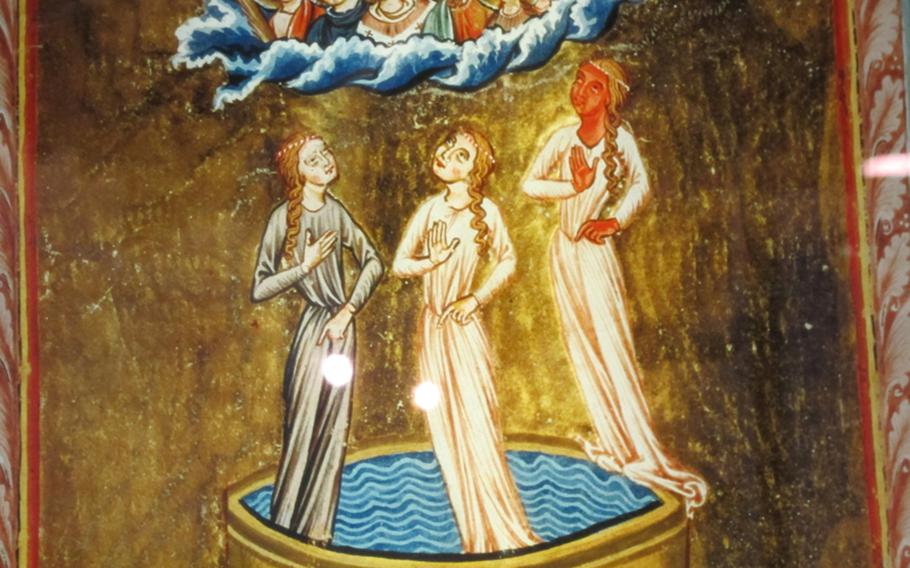
"The Fountain of Life," one of the many illustrations in Hildegard of Bingen's illuminated works at a museum dedicated to the 12-century nun in Bingen, Germany. (Nancy Montgomery/Stars and Stripes)
2 a.m.: Read scripture.
Dawn: Pray. Do needlework. Study.
6:30 a.m.: Prayer service.
8:15 a.m.: Prayer service.
Noon: Prayer service, followed by lunch (in summer) and a two-hour nap.
2:30 p.m.: Prayers, followed by (in winter) the only meal of the day.
5 p.m.: Prayer service, followed by (in summer) second meal of the day.
7:15 p.m.: Prayers, followed by bedtime.
The daily schedule of medieval Benedictine nuns was not exactly eat, pray, love. In addition, the nuns put in eight hours of daily manual labor.
That’s the sort of thing one learns at a museum in Bingen, Germany, dedicated to the country’s most famous nun: Hildegard of Bingen.
Hildegard of Bingen, who lived a long life in 12th-century Germany, was an unusual woman and likely genius. She wrote a visionary cosmological work, composed music, started a convent, corresponded with the most important people of the day and even went on preaching tours — at a time when women were viewed as morally, physically and intellectually inferior.
Nowadays, she’s revered by feminists, natural healers and the Catholic Church.
The museum, officially called the Museum on the River: Hildegard of Bingen, covers two floors and is highlighted by numerous illuminations or illustrations in Hildegard’s literary works. It also has some Roman antiquities, including an unusual collection of early medical instruments. Found in 1925 in a Roman physician’s grave in Bingen were 67 instruments — “the most extensive set of antique medical tools ever found,” according to the museum.
Bingen, positioned in wine country on the Rhine at the mouth of the Nahe River, was settled by the Romans before the birth of Christ, themselves superceding Bronze Age Celts.
The Romans built citadels and bridges and established trade routes, but by the fifth century, they had been replaced by the Franks.
Like much of Europe, Bingen “suffered through countless bloody wars, sieges, gruesome epidemics and devastating fires,” according to the city’s tourist guide.
Its old town was flattened during World War II. As a result, Bingen is not a charming, cobblestoned, medieval town like Rothenburg or Heidelberg, although plenty of medieval structures still exist.
The Hildegard museum is in a former electricity power station on the banks of the Rhine. The 1898 neo-Gothic building was regarded as a “cathedral of progress.” The city’s other most storied feature, the Mouse Tower, on a small island in the Rhine, is visible from the museum. The Mouse Tower story is less uplifting than Hildegard’s. According to legend, it was where the evil archbishop of Mainz, Hatto II, sometime in the late 900s, was devoured by thousands of avenging mice. Hatto had brought on the attack, the legend says, by setting fire to a group of starving peasants, whose pleas for food annoyed him.
On the QT ...Directions: From the direction of Cologne/Bonn: Autobahn A61 via Koblenz in the direction of Ludwigshafen until the exit road Bingen-Mitte. From Wiesbaden: Take the A643 in the direction of Mainz. At the Mainzer Dreieck, take the A60 to the exit road Bingen-Ost. From the direction of Karlsruhe / Ludwigshafen Heidelberg: Take the A6 toward Frankfurt/Saarbrücken. Take Exit 21 and merge onto A61 toward Mainz/Koblenz. Take Exit 49 Bingen-Mitte. From Kaiserslautern: Take the A63 toward Frankfurt/Mainz. Take Exit 8 at Kreuz Alzey and merge onto A61 toward Köln/Koblenz. Then take Exit 49 Bingen-Mitte.
Costs: Entrance to the Hildegard museum is 3 euros (about $4) for adults.
Food: Restaurants, wine bars and ice cream shops are plentiful nearby.
Information: Visit Bingen’s website— Nancy Montgomery